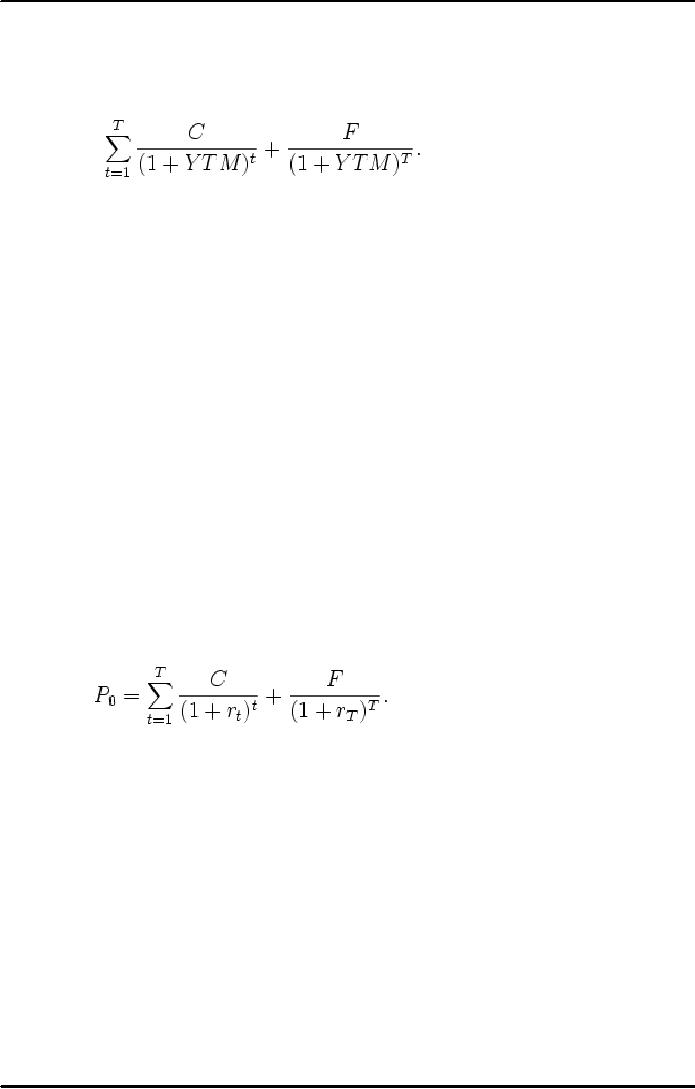 |

Corporate
Finance FIN 622
VU
Lesson
05
BOND
Bond
is a contract between an investor and the
issuer a company. It is a debt instrument
that a company
uses
to raise the capital and in
return pay interest to the
investors at per the terms of
contract. Bonds are
redeemable
it means that after a period of
time the company (issuer) returns the
money to the investors
and
liquidates its liability. The
rate at which issuer pays
interest to investors is known as
coupon rate.
Features
of Bond:
Coupon
Interest: stated
interest payments per
period
Face
value: also
Par value or the principal
amount
Coupon
rate:
interest payments stated in
annualized term.
Duration
or maturity date: The
date on which company
returns the principal amount back to
investors.
Current
yield: Annual
coupon payments divided by
bond price.
Discount
Bond: A bond
which is sold less than the
face or par value is discount
bond.
Premium
Bond: A bond
which is sold more than the
face or par value is premium
bond.
Interest
Rate Risk &
Bonds
The
risk arising from fluctuating
interest rate is known as
interest rate risk.
Interest
rate risk depends on how
sensitive bond price is to
interest rate change.
This
sensitivity depends upon two
things:
- Time
to maturity
-
Coupon rate
A
small change in interest
rate will have greater
impact on the on YTM and bond
value.
BOND
VALUATION:
Bond
valuation is the process of determining the
fair price of a bond. As
with any security, the fair
value of
a bond
is the present value of the stream of
cash flows it is expected to
generate. Hence, the price or
value
of a
bond is determined by discounting the bond's
expected cash flows to the
present using the appropriate
discount
rate.
General
relationships
Bond
pricing
1)
General relationships:
a) The
present value relationship:
The
fair price of a straight bond is
determined by discounting the expected cash
flows:
Cash
flows:
The
periodic coupon payments C,
each of which is made once
every period;
The
par or face value F, which
is payable at maturity of the bond after
T periods.
Discount
rate:
r is the
market interest rate for
new bond issues with
similar risk ratings
Bond
Price =
Because
the price is the present value of the
cash flows, there is an inverse
relationship between price
and
discount
rate: the higher the discount rates the
lower the value of the bond
(and vice versa). A bond
trading
below
its face value is trading at
a discount; a bond trading above
its face value is at a
premium.
b) Coupon
yield:
The
coupon yield is simply the coupon
payment (C) as a percentage of the
face value (F). Coupon
yield is
also
called nominal yield.
Coupon
yield = C / F
c)
Current yield:
The
current yield is simply the coupon
payment (C) as a percentage of the
bond price (P).
Current
yield = C / P0
17

Corporate
Finance FIN 622
VU
d)
Yield to Maturity:
The
yield to maturity (YTM), is the discount
rate which returns the maket
price of the bond. It is thus
the
internal
rate of return of an investment in the
bond made at the observed
price. YTM can also be used
to
price
a bond, where it is used as the required
return on the bond.
Solve
for YTM where
Market
Price =
To
achieve a return equal to
YTM, the bond owner must invest
each coupon received at this
rate.
Points to
remember:
For a
bond selling above the face
value is said to sell at premium. It
means investor who buys it at
a
premium
face a capital loss over the
life of bond. So return on
bond will be less than the
current yield.
For a
bond selling below the face
value is said to sell at
discount. This means capital
gain at maturity. The
return
on this bond is greater than its current
yield.
If
interest rates do not
change, the bond price
changes with time so that
total return on the bond is
equal to
yield
to maturity.
If YTM
increases, the rate of return
will be less than
yield.
If the YTM
decreases, the rate of return
will be greater than
yield.
2) Bond
pricing:
a)
Relative price approach:
Here
the bond will be priced relative to a
benchmark, usually a government security.
The discount rate
used
to
value the bond is determined based on the
bond's rating relative to a government
security with similar
maturity.
The better the quality of the bond, the
smaller the spread between
its required return and
the
YTM of the
benchmark. This required return is
then used to discount the bond
cash flows.
b) Arbitrage
free pricing approach:
In this
approach, the bond price
will reflect its arbitrage
free price. Here, each cash
flow is priced separately
and is
discounted at the same rate as the
corresponding government issue Zero
coupon bond. Since
each
bond
cash flow is known with
certainty, the bond price today must be
equal to the sum of each of
its cash
flows
discounted at the corresponding risk free
rate - i.e. the corresponding government
security.
Here
the discount rate per cash
flow, rt, must match
that of the corresponding zero coupon
bond's rate.
Bond
Price =
18
Table of Contents:
- INTRODUCTION TO SUBJECT
- COMPARISON OF FINANCIAL STATEMENTS
- TIME VALUE OF MONEY
- Discounted Cash Flow, Effective Annual Interest Bond Valuation - introduction
- Features of Bond, Coupon Interest, Face value, Coupon rate, Duration or maturity date
- TERM STRUCTURE OF INTEREST RATES
- COMMON STOCK VALUATION
- Capital Budgeting Definition and Process
- METHODS OF PROJECT EVALUATIONS, Net present value, Weighted Average Cost of Capital
- METHODS OF PROJECT EVALUATIONS 2
- METHODS OF PROJECT EVALUATIONS 3
- ADVANCE EVALUATION METHODS: Sensitivity analysis, Profitability analysis, Break even accounting, Break even - economic
- Economic Break Even, Operating Leverage, Capital Rationing, Hard & Soft Rationing, Single & Multi Period Rationing
- Single period, Multi-period capital rationing, Linear programming
- Risk and Uncertainty, Measuring risk, Variability of return–Historical Return, Variance of return, Standard Deviation
- Portfolio and Diversification, Portfolio and Variance, Risk–Systematic & Unsystematic, Beta – Measure of systematic risk, Aggressive & defensive stocks
- Security Market Line, Capital Asset Pricing Model – CAPM Calculating Over, Under valued stocks
- Cost of Capital & Capital Structure, Components of Capital, Cost of Equity, Estimating g or growth rate, Dividend growth model, Cost of Debt, Bonds, Cost of Preferred Stocks
- Venture Capital, Cost of Debt & Bond, Weighted average cost of debt, Tax and cost of debt, Cost of Loans & Leases, Overall cost of capital – WACC, WACC & Capital Budgeting
- When to use WACC, Pure Play, Capital Structure and Financial Leverage
- Home made leverage, Modigliani & Miller Model, How WACC remains constant, Business & Financial Risk, M & M model with taxes
- Problems associated with high gearing, Bankruptcy costs, Optimal capital structure, Dividend policy
- Dividend and value of firm, Dividend relevance, Residual dividend policy, Financial planning process and control
- Budgeting process, Purpose, functions of budgets, Cash budgets–Preparation & interpretation
- Cash flow statement Direct method Indirect method, Working capital management, Cash and operating cycle
- Working capital management, Risk, Profitability and Liquidity - Working capital policies, Conservative, Aggressive, Moderate
- Classification of working capital, Current Assets Financing – Hedging approach, Short term Vs long term financing
- Overtrading – Indications & remedies, Cash management, Motives for Cash holding, Cash flow problems and remedies, Investing surplus cash
- Miller-Orr Model of cash management, Inventory management, Inventory costs, Economic order quantity, Reorder level, Discounts and EOQ
- Inventory cost – Stock out cost, Economic Order Point, Just in time (JIT), Debtors Management, Credit Control Policy
- Cash discounts, Cost of discount, Shortening average collection period, Credit instrument, Analyzing credit policy, Revenue effect, Cost effect, Cost of debt o Probability of default
- Effects of discounts–Not effecting volume, Extension of credit, Factoring, Management of creditors, Mergers & Acquisitions
- Synergies, Types of mergers, Why mergers fail, Merger process, Acquisition consideration
- Acquisition Consideration, Valuation of shares
- Assets Based Share Valuations, Hybrid Valuation methods, Procedure for public, private takeover
- Corporate Restructuring, Divestment, Purpose of divestment, Buyouts, Types of buyouts, Financial distress
- Sources of financial distress, Effects of financial distress, Reorganization
- Currency Risks, Transaction exposure, Translation exposure, Economic exposure
- Future payment situation – hedging, Currency futures – features, CF – future payment in FCY
- CF–future receipt in FCY, Forward contract vs. currency futures, Interest rate risk, Hedging against interest rate, Forward rate agreements, Decision rule
- Interest rate future, Prices in futures, Hedging–short term interest rate (STIR), Scenario–Borrowing in ST and risk of rising interest, Scenario–deposit and risk of lowering interest rates on deposits, Options and Swaps, Features of opti
- FOREIGN EXCHANGE MARKET’S OPTIONS
- Calculating financial benefit–Interest rate Option, Interest rate caps and floor, Swaps, Interest rate swaps, Currency swaps
- Exchange rate determination, Purchasing power parity theory, PPP model, International fisher effect, Exchange rate system, Fixed, Floating
- FOREIGN INVESTMENT: Motives, International operations, Export, Branch, Subsidiary, Joint venture, Licensing agreements, Political risk